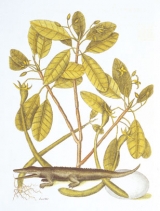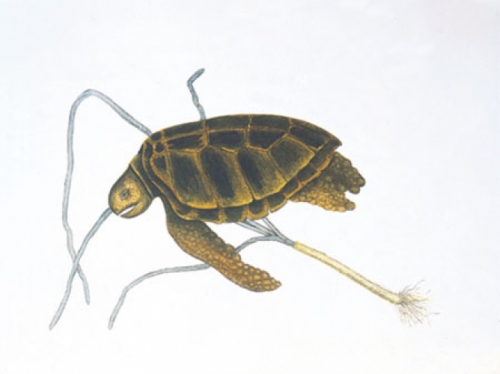Waters teeming with five-foot long sturgeon and codfish. Oyster reefs so high and numerous that ship captains fear navigating the waters. Gray whales swimming offshore. It sounds like an exotic, untouched land, and it was—the East Coast in the 1500s and 1600s.
Charles Peterson, professor of marine sciences, barely stops for breath as he tells story after story of marine animals lost to human exploitation—in North Carolina, Virginia, the Caribbean, Florida, Alaska. But the problem isn’t just that we don’t have as many pretty animals to admire. According to a study conducted by Peterson, his friend and colleague Jeremy Jackson, and other researchers, the overfishing and overharvesting of marine animals that began long ago has markedly changed the balance of life in our waters.
Peterson was drawn into these stories by Jackson, of the Scripps Institution of Oceanography. Jackson loves reading historical accounts written by sea captains, especially a pirate named William Dampier. Many of these captains had to become amateur natural historians to survive waters rife with coral reefs or other dangers. “Sometimes they had to feed a crew that had run out of supplies, and here they were on a strange shoreline, and so they had to know how to survive,” Peterson says.
With Dampier’s accounts as well as British records of turtle hunting, Jackson concluded that tens of millions of turtles, some as large as 500 pounds, lived in the Caribbean in the 1700s. But people heavily harvested the animals for their meat and for their shells. Records show that between 1688 and 1730, people harvested 13,000 turtles from one island alone. As the turtle population dwindled, turtle grass went ungrazed and grew out of control. The grass eventually began to rot, depleting the water’s oxygen and killing fish and shrimp.
Jackson suspected that similar scenarios had played out in many marine habitats. A “keystone” species is overharvested, disrupting an important function—such as the turtles eating the sea grass. An alternate species may take over the keystone’s function and keep the system going. But when that second species runs into trouble, the whole system can collapse, resulting in poor water conditions or overgrowth of pests. The effect may not be felt until years after the keystone species is first disrupted.
Jackson called on Peterson and 17 other colleagues to explore patterns of decline of species worldwide. The team looked at tropical coral reefs, kelp forests, sub-tidal shores, and estuaries in different parts of the world. Contributors included ecologists, who studied trade records and other historical documents; archeologists, who studied historical records and data from excavations of kitchen middens (scrap piles left behind by humans); and paleontologists, who studied fossils. The results of the group’s work were published in the July 27, 2001, issue of the journal Science.
The team searched back hundreds of years to get a baseline of how ecosystems looked before human intervention. Peterson explains why. “We have some feeling of how natural systems have changed over one, two, or, at most, three generations of human lifetimes.” And ecology as a discipline began only within the last 100 years. “That doesn’t come anywhere close to bringing us back to the period where we really started affecting these populations.”
As the team, including Karen Bjorndal of the University of Florida in Gainesville, studied turtles further, they found that the exploitation in the Caribbean began even before Europeans arrived. Middens created soon after American Indians reached the area between A.D. 600 and 800 are full of turtle bones, Bjorndal found. She estimates that today green turtle numbers are just 5 to 10 percent of their original level.
The story of another overexploited animal shows the value of diversity in the environment. “We talk about problems of declining diversity, and we have the Endangered Species Act to protect it,” Peterson says. “But people may ask, what damn good is it? Why do we need all that stuff?” One answer: in the Caribbean, herbivorous fishes grazed the seaweeds and kept them under control while carnivorous fishes ate and controlled, among other things, sea urchins. But people seriously overharvested both kinds of fishes. With its primary predators all but gone, the sea urchin population exploded. A stroke of luck was that the urchins grazed the seaweeds too. “So the immediate impact of the overfishing was not evident,” Peterson says. But when a virus struck the sea urchins, they were so numerous that it spread quickly. Now there are no fish, no urchins, and little coral on the reefs—the overgrown seaweeds block out the light that coral needs to survive.
“With the redundancy in function between the grazing fish and the grazing urchin, we were okay,” Peterson says. “Having removed those grazing fishes, the urchin was the last bastion of prevention of the overgrowth by seaweeds. So when that went, the whole system fell apart.”
Oysters are another example of a keystone species—and a favorite cause of Peterson’s. He’s working on a poster explaining their role in the estuary. “The oysters and oyster reefs used to be so abundant that when the colonial folks came here, you had to basically hire someone who knew the waters to guide your ship through these treacherous reefs,” he says. John Smith wrote of these conditions during his 1608 exploration of the James River in Virginia. Today, Peterson fears that oysters may be nearing extinction in some places.
Though they’re small, oysters affect water quality a great deal by their “filter feeding”—eating tiny particles from the water. In 1900 the oysters in the Chesapeake Bay could filter a volume of water equal to the entire bay in three days. Now it takes more than a year for the oysters there to filter the same amount of water. This filtering makes the water clearer, allowing in sunlight that nourishes sea grass, which provides living alcoves for fish.
Oysters’ waste products also improve water quality by promoting denitrification—turning nutrients into a gaseous form. This helps prevent fertilization and overgrowth of algae, which, when decomposing, can lower oxygen content enough to kill fish and shellfish. So while the widely publicized problems of low-oxygen water (called hypoxia) and fish kills in the Neuse River and other waters may be immediately caused by excess nitrogen from such pollutants as fertilizer runoff and car exhaust, the problem didn’t begin there. It began in part when people overharvested the water’s natural filters.
Not only do we exploit the oysters themselves, but our harvesting process does more damage. Dredging boats destroy oysters’ habitat—reefs made of calcium carbonate from spent oyster shells. Oysters living in high reefs are healthier because the reefs elevate them above the deeper waters, which is where hypoxia usually occurs. Peterson and graduate students Hunter Lenihan and Jon Grabowski used instruments to view the water below a certain depth during an anoxic event. “Right below that boundary, every oyster died,” Peterson says. “All the blue crabs left. The bottom was littered with dead shrimp.”
Also, water flows faster at the top, where it’s not slowed by friction with the muddy bottom. So oysters living in high reefs live in faster-flowing water, which means they get “greater food delivery” and that their wastes are carried off and dispersed more quickly. Oyster reefs also provide homes to fish, crabs, and shrimp. “For ten acres of oyster reef, each year you get two point five seven kilograms of fish and crab and shrimp created,” Peterson says. He bases the figure on his studies of fisheries data.
Peterson advocates reef-restoration projects such as one in place in the Chesapeake Bay. He also points to successful aquaculture programs in Oregon and Washington in which scientists are “farming” Asian oysters to replace the functionally extinct native oysters there. These highly managed systems of oysters are providing many of the water-filtering benefits that native oysters once did. North Carolina is behind in taking advantage of such programs to improve the oyster population, he says.
Despite what some media coverage has implied, Peterson emphasizes that this study details overharvesting that took place hundreds of years ago and isn’t meant as an indictment of today’s commercial fishing industry. But, the research group is continuing to work and meet, and they plan to decide whether they can use their findings to make a recommendation that might be useful to the industry.
Though marine animals are smaller and less numerous than hundreds of years ago, all hope isn’t lost. “On land, we have caused tremendous numbers of extinctions. The ivory-billed woodpecker and the Carolina parakeet are two examples that are close to home,” Peterson says. “But in the sea, despite all our modifications, the number of actual extinctions of organisms are few. That means that we have an opportunity to restore some of the past.”




